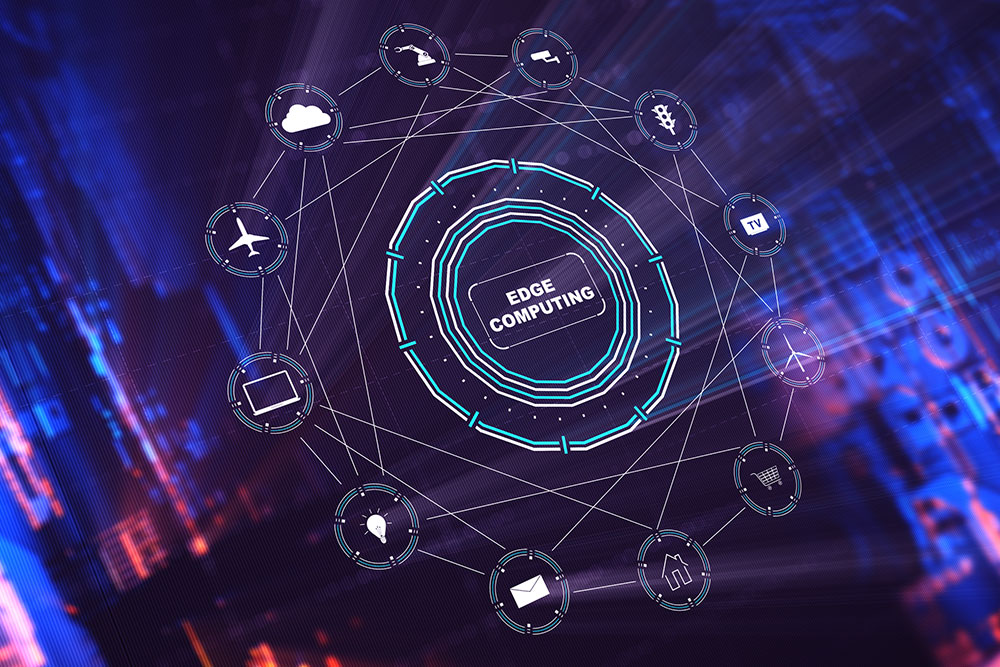Edge computing is a type of architecture which helps process and store data more efficiently and quickly. Rather than perform these tasks in a central data centre, they occur close to the data source itself (e.g. a factory floor or smart city). The central idea, therefore, is proximity to users, helping with response times and better bandwidth availability. In 2023, edge computing continues to move to new strengths across the world – presenting exciting opportunities for investors. In this industry report, our team at Bure Valley Group outlines the market in 2023, some key players, new entrants, trends, risks and prospects for the benefit of investor readers.
Edge computing in 2023: market overview
In 2021, the global edge computing market was estimated at $7.1 billion and is projected to reach $49.6 billion by 2028, representing a compound annual growth rate (CAGR) of 38.2%. A key driver of this growth is increased worldwide demand for cloud computing and interlinked devices (i.e. the “internet of things” or IoT). North America dominates the edge computing market and appears set to do so for some time, although Europe and Asia are also important regions. Edge computing is proliferating across verticals as technology innovates – including military, healthcare, energy and agriculture. The application potential is enormous, with SMEs increasingly turning to edge computing to fuel their growth plans.
Why edge computing?
We have all experienced the frustration of, say, a streaming service not loading – perhaps due to a connectivity issue. Yet in other spheres, data is far more sensitive and time-critical. Systems need to operate reliably and securely, such as in hospitals and traffic light systems in cities. Low latency is required, with users often depending on real-time data to be more proactive and adaptive. By bringing online data and algorithms “on site”, companies can innovate more quickly and potentially create new products and services “on the spot” based on data insights (e.g. about customer behaviour).
The truly exciting thing, moreover, is that edge computing has the potential to transform businesses across almost all sectors. Connected and “smart” street lights, aeroplanes, wind turbines, oil platforms, rail systems, power grids, vehicles (e.g. cars and freight trucks), factories and mobile devices are just a handful of innovations already in motion. Assets in an oil and gas company, for instance, can be remotely monitored and repaired.
Key trends and market forces
One study by Gartner predicts that 75% of all enterprise-generated data will be created outside of centralised data centres by 2025. The internet, already highly congested and disrupted due to current high reliance on these centres is leading IT architects to move their focus to the edge of the infrastructure (i.e. where data is generated). Often, a simple partial rack of gear can enable this to happen using a remote LAN (local area network).
The global move to 5G is expected to benefit the edge computing market. Linked devices such as smartphones are widely forecast to grow rapidly in number in the coming years. This, in turn, will almost certainly push up demand for more data capacity and lower latency. Customers, increasingly, want their various apps and goods to “talk to each other” – e.g. smart homes where the heating system, lighting, media players and even coffee machines are interconnected. Such solutions require quick access and analysis of data emanating from the user. On the national scale, moreover, governments are looking to raise productivity to grow their economies (especially where employment levels are already high). Higher levels of aggregate capital can be unlocked by introducing more edge computing solutions across industries.
Future opportunities & risks
It is hard to imagine a world in the near future where edge computing does not become more prevalent. Top players in the sector include Cisco (US), HPE (US), Huawei (China), IBM(US) and Dell Technologies (US), with the global market divided into various categories including application, components, organisation size and verticals. The great news is that investors can diversify their edge computing investments fairly easily due to their increasing penetration across markets, verticals and companies. A farming business, for instance, might use edge computing to track crop water use, nutrient density and weather conditions via sensors. Data is then collected to optimise crop-growing algorithms.
Transportation is another possibility. Here, a company might use edge computing to deploy a fleet of increasingly-efficient autonomous vehicles, using gathered data about location, speed, road conditions and other real-time traffic information. Retail could be another example. These businesses produce huge amounts of data such as customer purchases, surveillance, supplier details, distribution and inventory. An edge computing solution can help retail businesses analyse such data efficiently, quickly revealing areas of cost savings and sales opportunities (e.g. by developing new products which customers seem to be looking for).
A key risk to edge computing, of course, is security. Bringing data away from centralised centres reduces data risk somewhat since an outage (or breach) in a localised area is arguably less damaging than if it happened in a large data centre. However, the more devices are connected the more potential points of entry for hackers to steal data. Investors will need to keep an eye out for IoT services which emphasise encryption, policy-driven configuration enforcement and software patching to limit this risk. Finally, edge computing solutions may suffer from limited capability compared to large data centres. Therefore, investors should consider making sure that prospective companies for their portfolios have a clearly-defined scope and purpose of the edge deployment. This will help prevent a company from “overpromising” to investors and users on what it can realistically deliver.
Conclusion
If you are interested in expanding your portfolio into these kinds of exciting spheres of investing, then we invite you to get in touch with us here at Bure Valley and to consider joining our exclusive investor network:
+44 160 334 0827


